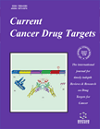- Home
- A-Z Publications
- Current Cancer Drug Targets
- Previous Issues
- Volume 10, Issue 4, 2010
Current Cancer Drug Targets - Volume 10, Issue 4, 2010
Volume 10, Issue 4, 2010
-
-
Inhibitors of the Sphingosine Kinase Pathway as Potential Therapeutics
More LessAuthors: M.R. Pitman and S.M. PitsonSphingosine kinase (SK) 1 and 2 are lipid kinases that phosphorylate sphingosine to form sphingosine-1 phosphate, a potent signalling molecule with pleiotrophic effects. SK1 is commonly up-regulated in tumours and its inhibition or genetic ablation has been shown to slow tumour growth as well as sensitise cancer cells to other chemotherapeutics. Therefore, SK1 is of particular interest as a target therapeutic intervention in canc Read More
-
-
-
Pharmacological Inhibition of Poly(ADP-ribose) Polymerase (PARP) Activity in PARP-1 Silenced Tumour Cells Increases Chemosensitivity to Temozolomide and to a N3-Adenine Selective Methylating Agent
More LessAuthors: L. Tentori, A. Muzi, A.S. Dorio, M. Scarsella, C. Leonetti, G.M. Shah, W. Xu, E. Camaioni, B. Gold, R. Pellicciari, F. Dantzer, J. Zhang and G. GrazianiWe recently demonstrated that poly(ADP-ribose) polymerase (PARP)-1 is involved in angiogenesis and tumour aggressiveness. In this study we have compared the influence of abrogation of PARP-1 expression by stable gene silencing to that of the pharmacological inhibition of cellular PARP activity using PARP-1/-2 inhibitors on the chemosensitivity of tumour cells to the wide spectrum methylating agent temozolomide (TMZ) Read More
-
-
-
Targeting CREB for Cancer Therapy: Friend or Foe
More LessAuthors: X. Xiao, B.X. Li, B. Mitton, A. Ikeda and K.M. SakamotoThe cyclic-AMP response element-binding protein (CREB) is a nuclear transcription factor activated by phosphorylation at Ser133 by multiple serine/threonine (Ser/Thr) kinases. Upon phosphorylation, CREB binds the transcriptional co-activator, CBP (CREB-binding protein), to initiate CREB-dependent gene transcription. CREB is a critical regulator of cell differentiation, proliferation and survival in the nervous system. Recent Read More
-
-
-
Molecular Pathways in the Progression of Hormone-Independent and Metastatic Prostate Cancer
More LessAuthors: B. Wegiel, S. Evans, R. Hellsten, L.E. Otterbein, A. Bjartell and J.L. PerssonOnce prostate cancer becomes castration resistant, cancer cells may rapidly gain the ability to invade and to metastasize to lymph nodes and distant organs. The progression through hormone-dependent to hormone-independent/ castration-resistant and metastatic PCa is poorly understood. In this review paper, we provide an overview on the cellular and molecular mechanisms underlying the process of tumor ce Read More
-
-
-
Recent Advances in Understanding Hormonal Therapy Resistant Prostate Cancer
More LessAuthors: K.V. Donkena, H. Yuan and C.Y. YoungAndrogen deprivation therapy has been the major treatment for advanced prostate cancer (PCa) and has shown to prolong life. However, remissions are temporary and patients almost inevitably progress to become castration-resistant prostate cancer (CRPC). CRPC is almost incurable even when treated with docetaxel that may have a slight life prolonging effect on CRPC patients. Interestingly, most of CRPC still express Read More
-
-
-
Human Mesenchymal Stem Cells (hMSCs) as Targets of DNA Damaging Agents in Cancer Therapy
More LessAuthors: S. Cruet-Hennequart, A.M. Prendergast, F.P. Barry and M.P. CartyHuman mesenchymal stem cells (hMSCs) consist of cells that can differentiate into mesenchymal tissues, including osteoblasts, adipocytes and chondrocytes. hMSCs constitute a particular stem cell niche in the stromal compartment of the bone marrow, and play a role in maintaining the normal function of haematopoietic stem cells. Furthermore, hMSCs localise to solid tumours, and can modulate cancer cell function thro Read More
-
-
-
Tyrosine Kinase Inhibitors Gefitinib, Lapatinib and Sorafenib Induce Rapid Functional Alterations in Breast Cancer Cells
More LessAuthors: S. Carloni, F. Fabbri, G. Brigliadori, P. Ulivi, R. Silvestrini, D. Amadori and W. ZoliAlterations in tyrosine kinase expression or functionality have been linked to tumor growth, and detailed analysis of tyrosine kinase pathways has led to the development of novel anticancer drugs based on their inhibition. The aim of the present work was to examine the cytotoxicity and cellular alterations correlated with multidrug resistance mechanisms induced by three tyrosine kinase inhibitors, lapatinib, sorafenib and Read More
-
Volumes & issues
-
Volume 25 (2025)
-
Volume 24 (2024)
-
Volume 23 (2023)
-
Volume 22 (2022)
-
Volume 21 (2021)
-
Volume 20 (2020)
-
Volume 19 (2019)
-
Volume 18 (2018)
-
Volume 17 (2017)
-
Volume 16 (2016)
-
Volume 15 (2015)
-
Volume 14 (2014)
-
Volume 13 (2013)
-
Volume 12 (2012)
-
Volume 11 (2011)
-
Volume 10 (2010)
-
Volume 9 (2009)
-
Volume 8 (2008)
-
Volume 7 (2007)
-
Volume 6 (2006)
-
Volume 5 (2005)
-
Volume 4 (2004)
-
Volume 3 (2003)
-
Volume 2 (2002)
-
Volume 1 (2001)
Most Read This Month
Article
content/journals/ccdt
Journal
10
5
false
en


